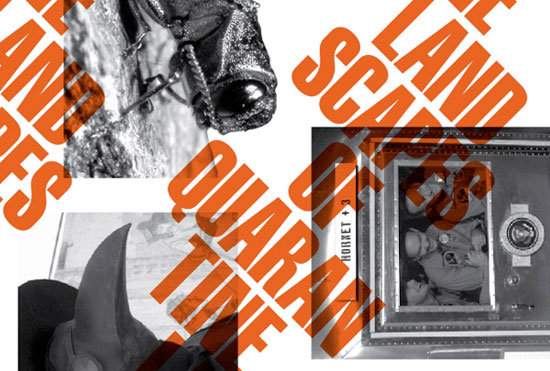Landscapes of Quarantine
dal 8/3/2010 al 16/4/2010
Segnalato da
Storefront for Art and Architecture
8/3/2010
Landscapes of Quarantine
Storefront for Art and Architecture, New York
Group exhibition exploring the spaces of quarantine, from Level 4 biocontainment labs to underground nuclear waste repositories. The show features new works by a multi-disciplinary group of eighteen artists, designers, and architects, each of whom was inspired by one or more of the physical, biological, ethical, architectural, social, political, temporal, and even astronomical dimensions of quarantine.

Curated by Future Plural
Geoff Manaugh, BLDGBLOG
Nicola Twilley, Edible Geography
Designed by Glen Cummings, MTWTF
Landscapes of Quarantine features new works by a multi-disciplinary group of eighteen artists, designers, and architects, each of whom was inspired by one or more of the physical, biological, ethical, architectural, social, political, temporal, and even astronomical dimensions of quarantine.
At its most basic, quarantine is a strategy of separation and containment—the creation of a hygienic boundary between two or more things, for the purpose of protecting one from exposure to the other. It is a spatial response to suspicion, threat, and uncertainty. From Chernobyl’s Zone of Exclusion and the artificial quarantine islands of the New York archipelago to camp beds set up to house HIV-positive Haitian refugees detained at Guantánamo and the modified Airstream trailer from within which Buzz Aldrin, Neil Armstrong, and Michael Collins once waved at President Nixon, the landscapes of quarantine are various, mutable, and often unexpected.
Typically, quarantine is thought of in the context of disease control. It is used to isolate people who have been exposed to a contagious virus or bacteria and, as a result, may (or may not) be carrying the infection themselves. But quarantine does not apply only to people and animals. Its boundaries can be set up for as long as needed, creating spatial separation between clean and dirty, safe and dangerous, healthy and sick, foreign and native—however those labels are defined.
As a result, the practice of quarantine extends far beyond questions of epidemic control and pest-containment strategies to touch on issues of urban planning, geopolitics, international trade, ethics, immigration, and more. And although the practice dates back at least to the arrival of the Black Death in medieval Venice, if not to Christ’s 40 days in the desert, quarantine has re-emerged as an issue of urgency and importance in today’s era of globalization, antibiotic resistance, emerging diseases, pandemic flu, and bio-terrorism.
Landscapes of Quarantine began with an eight-week independent design studio directed by Geoff Manaugh and Nicola Twilley of Future Plural. Each Tuesday evening, from October to December 2009, a multi-disciplinary group of studio participants met to discuss the spatial implications of quarantine and develop their own creative response: the resulting work forms the core of the Landscapes of Quarantine exhibition.
Works on display:
Pages 179 – 187, Joe Alterio
Q-CITY: An Investigation, Front Studio | Yen Ha & Michi Yanagishita
MAP 002 QUARANTINE, David Garcia Studio
Did We Build The Frontier To Keep It Closed?, Scott Geiger
Field Notes from Quarantine, Katie Holten
Hotel III, Camp II, Lab IV, Cell V, Mimi Lien
Cordon Sanitaire, Kevin Slavin
Context/Shift, Brian Slocum
Containing Uncertainty, Smudge Studio | Jamie Kruse & Elizabeth Ellsworth
NYCQ, Amanda Spielman & Jordan Spielman
Quick, Richard Mosse
Thermal Scanner and Body Temperature Alert System, Daniel Perlin
Precious Isolation: A Pair of Invasive Species, Thomas Pollman
Opening reception: Tuesday, March 9, 7pm
Storefront for Art and Architecture
97 Kenmare Street New York, NY 10012
Hours: Tuesday - Saturday 11:00am - 6:00pm
Closed Sunday and Monday



